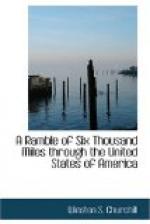New Orleans is seated on the south-east bank of the Mississippi; and, following the sinuosities of the current, about 109 miles from the Gulf of Mexico. The river takes here a right-angular sweep, and the city proper is built on the exterior point of the bend, the fauxbourgs extending at each side along the banks. At high water the river rises three feet above any part of the city; consequently, were it not for levees that have been constructed here, and also along the banks of the river for more than a hundred miles, at both sides, above and below, the whole country would be periodically inundated. The fall from the levee to Bayou St. John, which communicates with Lac Pontchartrain, is about thirty feet, and the distance one mile. This fall is certainly inconsiderable; but I apprehend that it would be sufficient to drain the streets effectually, if proper attention were directed to that object.
The city extends only half-a-mile back, and, including the fauxbourgs, about two miles along the river. The streets, being only partially paved, can never be perfectly cleaned, and stagnant water remains in the kennels at all seasons; this and the exhalations from the swamps in warm weather, produce that pestilential scourge with which the place is annually afflicted. The mortality here last season (the autumn of 1829) has been variously stated in the public prints at from five to seven thousand, who died of the yellow fever in the space of about ten weeks. This statement, however, is erroneous; as, from information which I received from the sexton of the American grave-yard, and from the number of fresh graves which I saw there, I am inclined to think that the total amount falls short of 2500, out of a resident population of less than 40,000 souls. About 700 were buried in the American grave-yard, and perhaps double that number in that of the French.
The port of New Orleans presents the most extraordinary medley of any port in the world. Craft of every possible variety may be seen moored along the levees, and the markets and adjacent streets crowded with people of almost every nation in Europe, Africa, and America, who create a frightful confusion of tongues. A particular part of the quay is appropriated to each description of craft, and a penalty is enforced for any deviation from port regulations. The upper part is occupied with flat-boats, arks, peeroges, rafts, keel-boats, canoes, and steam-boats; and below these are stationed schooners, cutters, brigs, ships, &c., in regular succession. The levee is almost constantly filled with merchandize; and the scene of bustle and confusion which is exhibited here during the early part of the day, fully proves the large amount of commercial intercourse which this city enjoys.




